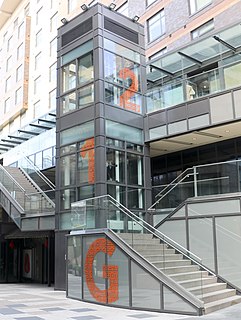Related Research Articles
In computer science, specifically software engineering and hardware engineering, formal methods are a particular kind of mathematically rigorous techniques for the specification, development and verification of software and hardware systems. The use of formal methods for software and hardware design is motivated by the expectation that, as in other engineering disciplines, performing appropriate mathematical analysis can contribute to the reliability and robustness of a design.
Software development is the process of conceiving, specifying, designing, programming, documenting, testing, and bug fixing involved in creating and maintaining applications, frameworks, or other software components. Software development is a process of writing and maintaining the source code, but in a broader sense, it includes all that is involved between the conception of the desired software through to the final manifestation of the software, sometimes in a planned and structured process. Therefore, software development may include research, new development, prototyping, modification, reuse, re-engineering, maintenance, or any other activities that result in software products.
In the context of hardware and software systems, formal verification is the act of proving or disproving the correctness of intended algorithms underlying a system with respect to a certain formal specification or property, using formal methods of mathematics.

In computer science, model checking or property checking is a method for checking whether a finite-state model of a system meets a given specification. This is typically associated with hardware or software systems, where the specification contains liveness requirements as well as safety requirements.
The Web Services Business Process Execution Language (WS-BPEL), commonly known as BPEL, is an OASIS standard executable language for specifying actions within business processes with web services. Processes in BPEL export and import information by using web service interfaces exclusively.
A modeling language is any artificial language that can be used to express information or knowledge or systems in a structure that is defined by a consistent set of rules. The rules are used for interpretation of the meaning of components in the structure.
In software project management, software testing, and software engineering, verification and validation (V&V) is the process of checking that a software system meets specifications and that it fulfills its intended purpose. It may also be referred to as software quality control. It is normally the responsibility of software testers as part of the software development lifecycle. In simple terms, software verification is: "Assuming we should build X, does our software achieve its goals without any bugs or gaps?" On the other hand, software validation is: "Was X what we should have built? Does X meet the high level requirements?"

Model-based testing is an application of model-based design for designing and optionally also executing artifacts to perform software testing or system testing. Models can be used to represent the desired behavior of a system under test (SUT), or to represent testing strategies and a test environment. The picture on the right depicts the former approach.
The B method is a method of software development based on B, a tool-supported formal method based on an abstract machine notation, used in the development of computer software. It was originally developed in the 1980s by Jean-Raymond Abrial in France and the UK. B is related to the Z notation and supports development of programming language code from specifications. B has been used in major safety-critical system applications in Europe. It has robust, commercially available tool support for specification, design, proof and code generation.
In computer science, formal specifications are mathematically based techniques whose purpose are to help with the implementation of systems and software. They are used to describe a system, to analyze its behavior, and to aid in its design by verifying key properties of interest through rigorous and effective reasoning tools. These specifications are formal in the sense that they have a syntax, their semantics fall within one domain, and they are able to be used to infer useful information.
In computer science, an abstract state machine (ASM) is a state machine operating on states that are arbitrary data structures.
Runtime verification is a computing system analysis and execution approach based on extracting information from a running system and using it to detect and possibly react to observed behaviors satisfying or violating certain properties. Some very particular properties, such as datarace and deadlock freedom, are typically desired to be satisfied by all systems and may be best implemented algorithmically. Other properties can be more conveniently captured as formal specifications. Runtime verification specifications are typically expressed in trace predicate formalisms, such as finite state machines, regular expressions, context-free patterns, linear temporal logics, etc., or extensions of these. This allows for a less ad-hoc approach than normal testing. However, any mechanism for monitoring an executing system is considered runtime verification, including verifying against test oracles and reference implementations. When formal requirements specifications are provided, monitors are synthesized from them and infused within the system by means of instrumentation. Runtime verification can be used for many purposes, such as security or safety policy monitoring, debugging, testing, verification, validation, profiling, fault protection, behavior modification, etc. Runtime verification avoids the complexity of traditional formal verification techniques, such as model checking and theorem proving, by analyzing only one or a few execution traces and by working directly with the actual system, thus scaling up relatively well and giving more confidence in the results of the analysis, at the expense of less coverage. Moreover, through its reflective capabilities runtime verification can be made an integral part of the target system, monitoring and guiding its execution during deployment.
The VIATRA framework is the core of a transformation-based verification and validation environment for improving the quality of systems designed using the Unified Modeling Language by automatically checking consistency, completeness, and dependability requirements.
Executable UML is both a software development method and a highly abstract software language. It was described for the first time in 2002 in the book "Executable UML: A Foundation for Model-Driven Architecture". The language "combines a subset of the UML graphical notation with executable semantics and timing rules." The Executable UML method is the successor to the Shlaer–Mellor method.
The Business Process Definition Metamodel (BPDM) is a standard definition of concepts used to express business process models, adopted by the OMG. Metamodels define concepts, relationships, and semantics for exchange of user models between different modeling tools. The exchange format is defined by XSD and XMI, a specification for transformation of OMG metamodels to XML. Pursuant to the OMG's policies, the metamodel is the result of an open process involving submissions by member organizations, following a Request for Proposal (RFP) issued in 2003. BPDM was adopted in initial form in July 2007, and finalized in July 2008.

Behavior trees are a formal, graphical modelling language used primarily in systems and software engineering. Behavior trees employ a well-defined notation to unambiguously represent the hundreds or even thousands of natural language requirements that are typically used to express the stakeholder needs for a large-scale software-integrated system.
The JAUS Tool Set (JTS) is a software engineering tool for the design of software services used in a distributed computing environment. JTS provides a Graphical User Interface (GUI) and supporting tools for the rapid design, documentation, and implementation of service interfaces that adhere to the Society of Automotive Engineers' standard AS5684A, the JAUS Service Interface Design Language (JSIDL). JTS is designed to support the modeling, analysis, implementation, and testing of the protocol for an entire distributed system.

Sparx Systems Enterprise Architect is a visual modeling and design tool based on the OMG UML. The platform supports: the design and construction of software systems; modeling business processes; and modeling industry based domains. It is used by businesses and organizations to not only model the architecture of their systems, but to process the implementation of these models across the full application development life-cycle.

WebAssembly is an open standard that defines a portable binary-code format for executable programs, and a corresponding textual assembly language, as well as interfaces for facilitating interactions between such programs and their host environment. The main goal of WebAssembly is to enable high-performance applications on web pages, but the format is designed to be executed and integrated in other environments as well, including standalone ones.
Protocol engineering is the application of systematic methods to the development of communication protocols. It uses many of the principles of software engineering, but it is specific to the development of distributed systems.
References
- R. Farahbod, V. Gervasi, U. Glässer and M. Memon. Design Exploration and Experimental Validation of Abstract Requirements, Proceedings of the 12th International Working Conference on Requirements Engineering: Foundation for Software Quality (REFSQ'06), June 2006, Luxembourg, Grand-Duchy of Luxembourg, Essener Informatik Beitrage, ISBN 3-922602-26-6.
- R. Farahbod, V. Gervasi, U. Glässer, and M. Memon. Design and Specification of the CoreASM Execution Engine, Part 1: the Kernel. Technical Report SFU-CMPT-TR-2006-09, Simon Fraser University, May 2006.
- R. Farahbod, V. Gervasi, and U. Glässer. CoreASM: An extensible ASM execution engine. In D. Beauquier, E. Börger and A. Slissenko (Eds.), Proc. 12th International Workshop on Abstract State Machines, Paris, March 2005, pages 153–165
- ... further references and documentation